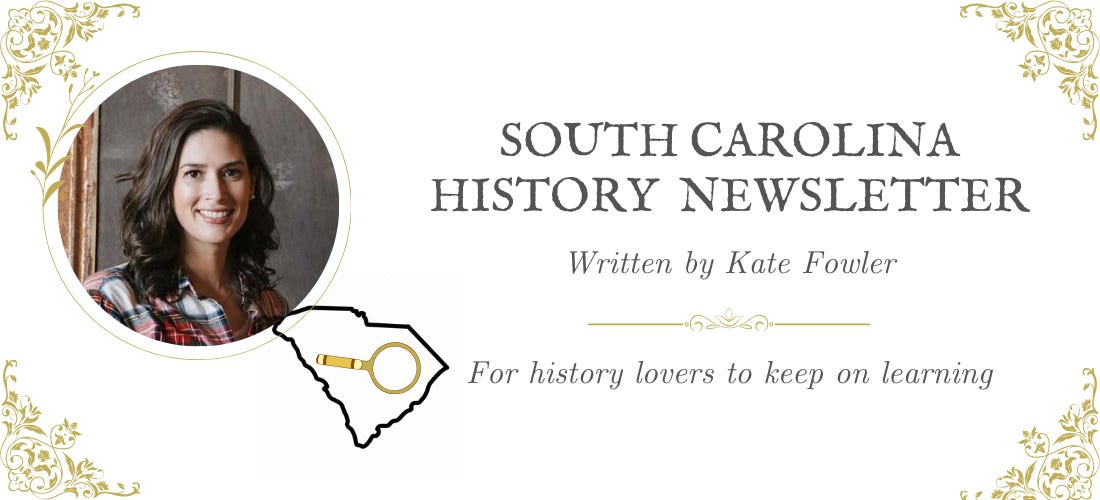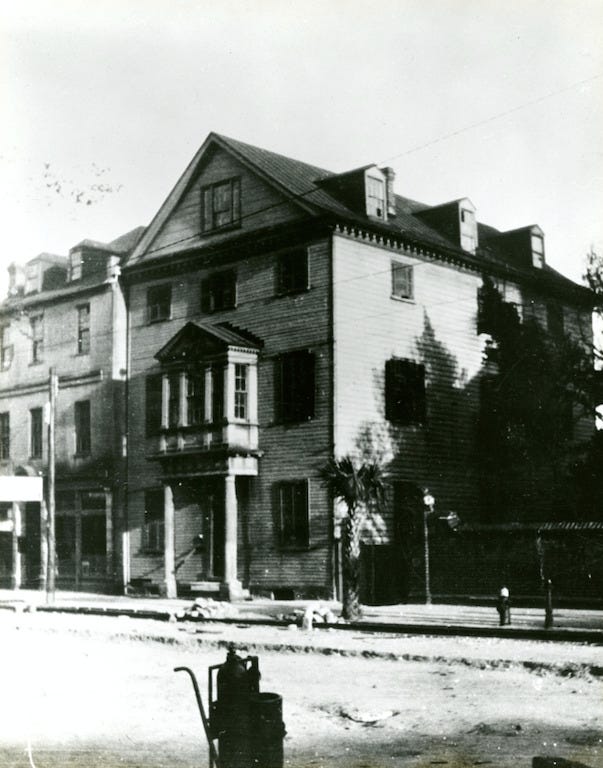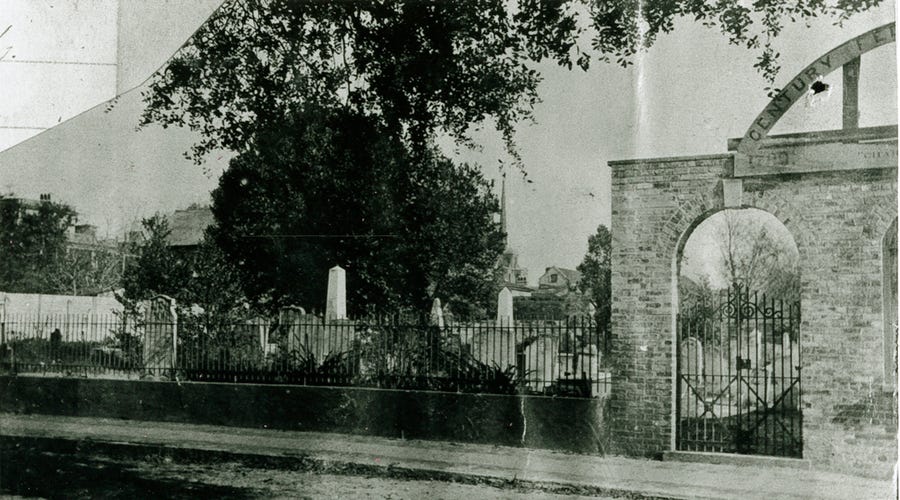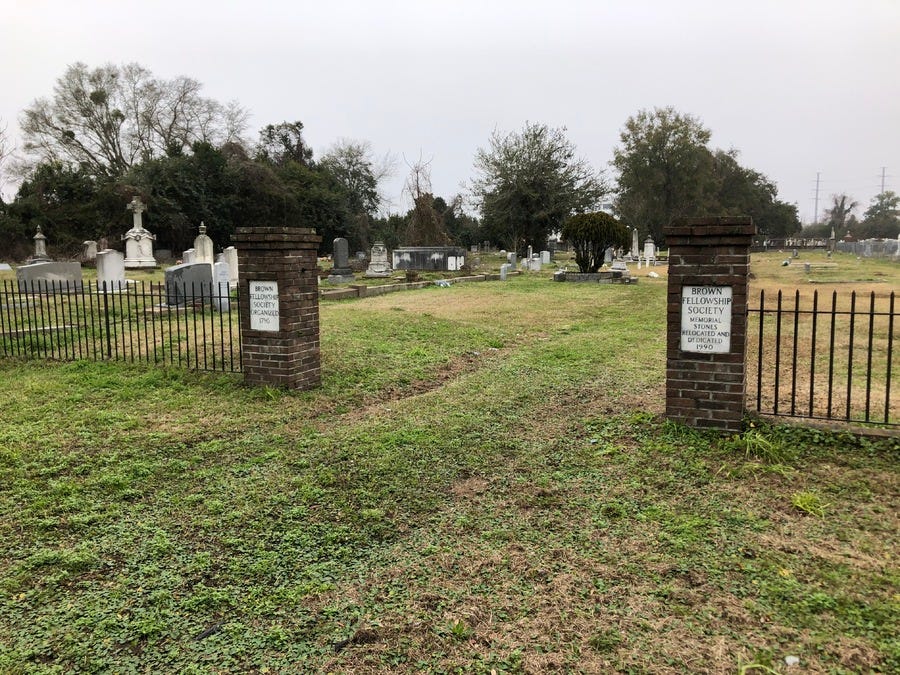#39: Jehu Jones Sr., the Brown Fellowship Society, and a lecture on the 1706 French and Spanish Invasion
For South Carolina history lovers far and wide! Enjoy weekly SC history and upcoming SC historical events
Dear reader,
Welcome to Newsletter #39 of The South Carolina History Newsletter! I’m so happy you’re here.
I hope you enjoy today’s newsletter, and as always, please feel free to reply to this email with your ideas and suggestions on South Carolina history you’d like to learn more about. I’m only a click away.
Additionally, please join us & keep the conversation going by becoming a member of our SC History Newsletter Facebook Community here! I can’t wait to meet you.
And now, let’s learn some South Carolina history!
Yours truly,
Kate
(Writing from Greenville, SC)
➳ Featured SC History Event
Please enjoy our featured SC History Event below, and click here to visit my SC History Events Calendar that organizes all the upcoming SC history events I have discovered. Please let me know if you’d like to add an event to the calendar! Reply to this email or send me a note at schistorynewsletter@gmail.com.
Saturday, March 30th at 2:00 pm | “1706 French and Spanish Invasion in SC presented by Historian George McDaniel” | Wando Library | Mount Pleasant, SC | FREE & Open to the public
“The Town of Mount Pleasant Historical Commission will be hosting a talk with South Carolina Battleground Preservation Trust Historian George McDaniel. The discussion will feature new research on the 1706 French and Spanish invasion conducted by the late Doug Bostick in collaboration with the Mount Pleasant Historical Commission. The event is free and open to the public, and will be held at the Wando Library at 1400 Carolina Park Blvd.”
➳ SC History Fun Facts
I.
Did you know that Jehu Jones, Sr. was an enslaved worker in Charleston who purchased his own freedom, built and operated a luxury hotel, and would eventually amass a fortune of $1.3 million in today’s dollars?
Jehu Jones, Sr. (1769-1833) was born into slavery, and was the property of a successful Charleston tailor named Christopher Rogers. Growing up in Rogers’ household, Jones learned the tailoring trade, as well as powerful business knowledge that would benefit him later in life.
In late 1700s Charleston, there was a system called “hiring out,” which allowed slave owners to hire out their enslaved workers to business owners who needed cheap labor, but couldn’t afford the cost of purchasing slaves themselves. Slaves who were “hired out” performed a variety of jobs, many involving “labor, municipal jobs, and domestic work.” Jehu Jones was “hired out” to perform the tailoring skills he had learned from his master. While the details of Jones’s involvement with the hiring out system are not known, records reveal that Jones “purchased his freedom in 1798 for $140, most likely with money he earned” through the hiring out system.
After purchasing his freedom, Jones used his business savvy to begin to build — what would become — a remarkable and prosperous life for a free Black man in antebellum Charleston. Jones quickly established his own tailoring shop, which became very successful. With the profits from his tailoring business, by the early 1800s, Jones also delved into real estate ventures, purchasing “property downtown and on Sullivan’s Island in 1802.”
Over time, Jones himself gained enough wealth and prestige to join the Brown Fellowship Society, one of the “oldest benevolent societies for African Americans in South Carolina.” The Brown Fellowship Society was founded in 1790 by “Black and mulatto members” of St. Philips Episcopal Church who were restricted from using the church’s all white graveyard. (Note from Kate: See essay #2 below that goes into the history of The Brown Fellowship Society)
Because of his smart investments, Jones’ wealth continued to grow. In 1816, he purchased the Burrows-Hall House (33 Broad Street), and turned the building into an inn. Jones and his wife Abagail opened the Jones Hotel in 1816, which catered to elite whites only. Behind the scenes, Jones, a former slave himself, used enslaved labor to assist with the operations of running the “exclusive and luxurious inn.” As Jones Sr. focused on the hotel and his investments, he delegated the family tailoring business to his son, Jehu Jones, Jr.
The Denmark Vesey slave rebellion of 1822 affected the Jones family and other free Black citizens of South Carolina. Whether they were part of the elite Black society or not, all African Americans were “closely scrutinized and subjected to stricter regulations.” For example, adult African American men were supposed to be supervised by a white guardian. Free Black South Carolinians were not allowed to travel out of the state (and were barred from returning to the state if they traveled after the conspiracy) unless they sought “express permission from the state government.” Abagail Jones was traveling with her children and grandchildren in New York before 1822 and faced difficulty returning home, ultimately passing away in New York.
Jehu Jones, Sr. passed away in 1833. His estate was valued at $40,000 (about $1.3 million in today’s dollars) and was split between his three sons and his stepdaughter, Ann Deas.
Ann Deas and Eliza Johnson—another free Black Charlestonian—operated the inn until 1847. They continued to use enslaved labor at the Jones Hotel for “cooking extravagant cuisine, waiting on the inn’s white clientele, and cleaning and maintaining the establishment.”
Financial struggles in the 1840s forced Deas and Johnson to sell the Jones Hotel to a free African American couple, John Lee and Eliza Seymour Lee. They renamed the Jones Hotel to “Lee’s Boarding House” and continued the use of the property as an inn establishment serving very fine cuisine. The building that once housed the Jones Hotel was taken down in the 1920s, but the story of the inn and its owners reveals the many layers and complexities of life in Charleston society for free and enslaved African Americans.
II.
Did you know that before the Civil War, free Black citizens of Charleston created mutual aid societies to provide benefits to their communities that white churches denied them?
Founded in Charleston in 1790 (and mentioned in the essay above in Jehu Jones’ story), The Brown Fellowship Society was founded by 5 free “non-whites” who attended St. Philip’s Episcopal Church: James Mitchell, George Bampfield, William Cattel, George Bedon, and Samuel Saltus. The motto of the organization was “Charity and Benevolence” and its mission was “to provide benefits which the white church denied them like a proper burial ground, widow and orphan care, and assistance in times of sickness”.
The creation and upkeep of the Brown Fellowship Society’s cemetery was at the core of its mission, and it was located next to their meeting hall on Pitt Street.
At the time of the formation of the group, Charleston society recognized three races: White, Mulatto, and Negro, including octoroons and quadroons. Those who joined the club considered themselves “brown” mulattoes. The Society had 50 members. The membership process was rigorous. Each member had to pay an expensive (at the time) $50 membership fee, and went through three different votes before being admitted. The organization forbid talks about political or religious matters. The organization also cared for widows of members, provided a primary school, supported its members' businesses. Many of the members of the Brown Fellowship Society owned their own businesses and some were prosperous.
Originally, the society did not accept members who had darker skin. After the Civil War, the Brown Fellowship Society expanded to include more African Americans, including women and those of darker skin tones. However benevolent the organization was, The Brown Fellowship Society did not intervene in the status of slaves at the time.
Since the Brown Fellowship Society did not welcome everyone into its ranks, other African American mutual aid societies formed. In 1843, the Humane Brotherhood was organized and “modeled after the Brown Fellowship Society, but less class conscious.” In 1843, the free black man Thomas Smalls applied for a membership in the Brown Fellowship Society and was “turned down because he was too black.” Smalls set up his own society, The Society for Free Blacks of Dark Complexion (later renamed the Brotherly Society). He opened a graveyard for pure African descent, the MacPhelah cemetery, adjacent to the Brown Fellowship Graveyard, and another one, Ephrath (still intact today).
In 1892, the Brown Fellowship Society was renamed the Century Fellowship Society.
As the city of Charleston continued to grow, the Brown Fellowship Society cemetery became threatened. In 1943, the Society’s cemetery was purchased by the Roman Catholic Diocese of Charleston in order for a parking lot to be paved for Bishop England High School. A new property was purchased off of Cunnington Avenue in North Charleston to be used as the Society's new cemetery. The Diocese “promised to relocate the headstones, monuments, and remains to the new cemetery off of Cunnington, but there is no evidence that this occurred.” The photo below shows the entrance to the Brown Fellowship Society's 2nd cemetery off of Cunnington Ave. Tragically, plans proceeded and the original Brown Fellowship Society cemetery was paved over.
For many years afterwards, the Catholic Diocese continued to affirm that the original Brown Fellowship Cemetery “had been cleared of corpses,” but in 2001, 4 gravesites were discovered when the construction of the College of Charleston's Addlestone Library was launched at the cemetary’s original site. The records of the society are held at the College of Charleston’s Avery Research Center for African American History and Culture.
The College of Charleston erected a monument honoring the Brown Fellowship Society and its members and their families who were buried on the property. Each day, “students and staff at the College of Charleston pass through one of the most important sites in the history of the City’s African American community, whether they know it or not.”
➳ Quote from an SC historical figure
I.
“Charleston’s black population, comprising its majority for much of the city’s history, has been one of its most distinctive features. Yet, in a city whose name is synonymous with history and where monuments to the past punctuate the landscape, one would have searched in vain to find comparable recognition of the black past. That is until today. By recognizing these African-American cemeteries as an important site of memory, a significant chapter is being written in Charleston’s modern history. Simultaneously, homage is being paid to its past.”
—Dedication of the African-American Cemetery Memorial — February 7, 2008
Sources used in today’s newsletter:
I always want to improve my work. Answer the poll below to give me your review of today’s newsletter. I also welcome your suggestions for new content! Simply reply to this email with your ideas. Thank you!














